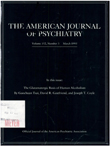Predicting response to amitriptyline in posttraumatic stress disorder
Abstract
OBJECTIVE: This study evaluated the relation between baseline clinical phenomena and response to amitriptyline in patients with posttraumatic stress disorder (PTSD). METHOD: Data were obtained from an 8-week placebo-controlled, double-blind study of combat veterans. Bivariate and multivariate statistics were used to evaluate the relations between the following variables and outcome: age, depression, anxiety, severity of PTSD symptoms, personality, psychiatric comorbidity, level of exposure to trauma, and individual symptoms of depression, anxiety, and traumatic stress. Outcome measures were scores on the Clinical Global Impression scale, Hamilton Rating Scale for Depression, Hamilton Rating Scale for Anxiety, and Impact of Event Scale. RESULTS: Drug response was related to lower baseline levels of depression, neuroticism, combat intensity, anxious mood, impaired concentration, somatic symptoms, feelings of guilt, and one intrusion and four avoidance symptoms of PTSD. CONCLUSIONS: The results demonstrate that response to amitriptyline is related to measures of depression, anxiety, PTSD, personality, and intensity of combat trauma. Similar relationships were not observed in the placebo group, suggesting a specific relationship to the drug.
Access content
To read the fulltext, please use one of the options below to sign in or purchase access.- Personal login
- Institutional Login
- Sign in via OpenAthens
- Register for access
-
Please login/register if you wish to pair your device and check access availability.
Not a subscriber?
PsychiatryOnline subscription options offer access to the DSM-5 library, books, journals, CME, and patient resources. This all-in-one virtual library provides psychiatrists and mental health professionals with key resources for diagnosis, treatment, research, and professional development.
Need more help? PsychiatryOnline Customer Service may be reached by emailing [email protected] or by calling 800-368-5777 (in the U.S.) or 703-907-7322 (outside the U.S.).



